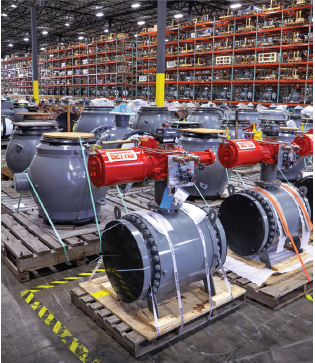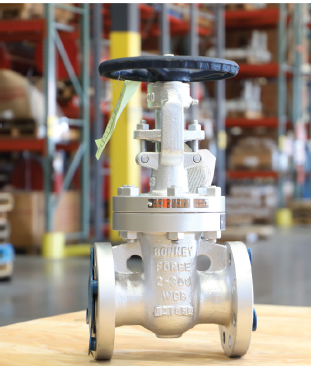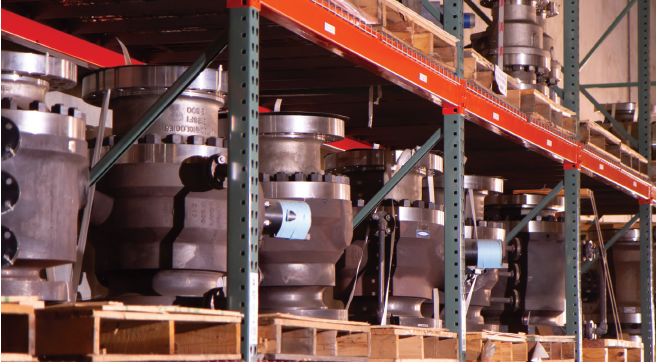The valve trifecta consists of the highest quality, best delivery, and lowest price. When looking to purchase a valve, these three aspects, in this specific order, should be taken into consideration, and together become the ideal standard in valve selection. Valve World Americas had the pleasure of speaking about the valve trifecta with Matt Hartfiel, Vice President of Downstream, Industrial & Energy Transition, and Charles Metrailer, Executive Director of Downstream Valves & Automation from MRC Global. In part one of this article, they discuss the importance of quality and lead times, while understanding and appreciating total cost of ownership.
By Charlie Evans and Angelica Pajkovic
When choosing a valve, there are numerous factors to consider. While it is ideal to strive for the best in all three categories, namely quality, delivery, and price, compromises must inevitably be made to select the right valve for the application. “Relying upon decades of industry experience, we continuously analyze each aspect within the trifecta and attempt to understand the importance of each in relation to the overall value for the customer,” said Hartfiel. “End users are becoming increasingly dependent upon knowledgeable suppliers to assist them in their decision-making processes.”
Quality
Contrary to popular belief, not all valves are created equal; some are designed and built for higher performance and longevity due to higher-quality materials and design. “Valves may look the same from the outside, but when taken apart, the differences between manufacturers and brands become clear,” said Metrailer. “Design Engineers often put their own tweak on the fabrication of the valve, effectively giving it its own personality. Ask yourself: why did they put those specific features in the valve? What are the added benefits?”
Considering these different factors is extremely important when it comes to proper valve selection. These considerations go handin- hand with material selection. “Without quality base metal, there will not be a quality product,” continued Metrailer. While higher grade material may cost more, it could lead to a longer-lasting product and subsequent lower total cost of ownership. Quality materials and well-designed products tend to require fewer repairs or replacements.This is important to consider when evaluating the initial price between two valves, especially if the less expensive one is of lower quality and will lead to a higher total cost of ownership in the end.
There are multiple factors that comprise quality in terms of valves, including the use of quality materials, as well as established and vetted foundries. “Quality starts with the base material, followed by the design, manufacturing and quality assurance processes, all of which lead to the completion of a valve. In each step of the manufacturing process, process control is critically important to ensure valves are produced in a consistent manner and fit for purpose,” said Metrailer.
Exceeding industry standards
“In the valve industry, regulating entities govern the minimum requirements and standards that all manufacturers must follow,” said Hartfiel, “such as API, ISO, and ASTM. A customer may look at a valve and see it meeting those standards and consider it technically equivalent to other approved valves. However, when looking behind the curtain, some manufacturers have different goals, performance metrics and business models than others.”
There are plenty of manufacturers who are content with simply meeting the minimum requirements, whereas some will design a valve that exceeds them which may ultimately result in a higher-quality overall product. “Manufacturers may build a more robust product than just the minimum standards, whether it is related to wall thickness, emissions, torque or other aspects,” continued Hartfiel. Going above and beyond expectations can make for a better product, one that may extend lifecycles, reduce costly emissions and worth considering when thinking about reliability and total cost of ownership.


Quality from a safety standpoint
Ensuring that valves do not fail to protect individuals and the environment is why industry standards exist. Valves are often installed in critical services where failure can result in dire consequences. “There have been times in the past where leaky valves, or valves that completely failed for one reason or another, have resulted in the loss of human life,” said Hartfiel, “and that should never be a consequence of a valve.”
“When thinking about quality, it must be considered in broad terms, including what services these valves are going into and what may occur if they fail,” Hartfiel continued. For example, valves are often used in chemical and petrochemical plants in corrosive and high-pressure applications where reliability is critically important. “Quality and reliability of a product can be thought of synonymously when it comes to what matters.”
Reliability and predictability
Reliability and predictability are crucial aspects of any industrial asset. “Oftentimes, manufacturers are trying to project reliability and predictability to their vendors and end users,” said Metrailer. “End users want to have the reliability that the valve is going to adequately function when it is needed, and the predictability that the valve is going to be received in time for a turnaround. Manufacturers have therefore begun to place a large focus on this aspect of their business.”
Diligence in delivery
Although the delivery of a product may not appear to be one of the most important factors to consider, delayed delivery times can have a significant impact on production. “Planning becomes critically important when ordering a new valve,” said Hartfiel. “It is crucial to anticipate all the potential challenges that may arise and to attempt to mitigate the risk of unexpected setbacks. Devising a solution in advance can help meet delivery expectations, and ongoing projects and turnarounds will be executed on schedule. Waiting longer than initially anticipated for a valve replacement can lead to significant profit losses and can be damaging to long term relationships.”
Over the last 30 years, there has been a much lower percentage of on-time deliveries for critical assets in the industrial sector than one might think. “A dramatic rise in the amount of data being collected has provided us with some unfortunate insights into how common missed delivery dates have become,” relayed Metrailer. “The positive takeaway from this datagathering process has been the ability to use the delivery trends to our advantage and ultimately to the benefit of our customers.
We are able to provide our customers with the delivery information they need to make informed decisions regarding any risks associated with potentially late material.” The delivery and post-installation costs must also be looked at in terms of the total cost of ownership; this entails the cost of the asset plus any related costs of operation, maintenance, or replacement. “Oftentimes with the least expensive valve, you may have to compromise on a longer lead-time,” explained Hartfiel. “In today’s fast-paced business environment, project schedules are compressing and “fast-track” capital work is becoming a growing trend. This gives a competitive advantage to manufacturers that offer predictable, shorter lead-time solutions.
The takeaway
When looking at these first two aspects of the valve trifecta, quality and delivery, the crucial underlying factor that becomes clear is the importance of planning. To optimize
the two, end users must have a solid plan in place that addresses the required safety, reliability and delivery expectations of the product or products that they are considering. 
Stay tuned for part two of this article to look at how price factors into the valve trifecta and the importance of providing end users with key strategies for valve procurement.
About this Featured Story
This Featured Story is an article from our Valve World Magazine, September 2023 issue. To read other featured stories and many more articles, subscribe to our print magazine. Available in both print and digital formats. DIGITAL MAGAZINE SUBSCRIPTIONS ARE NOW FREE.
“Every week we share a new Featured Story with our Valve World community. Join us and let’s share your Featured Story on Valve World online and in print.”


